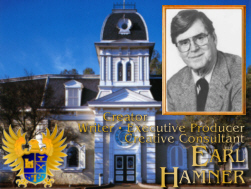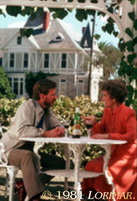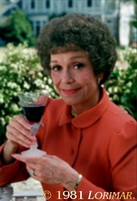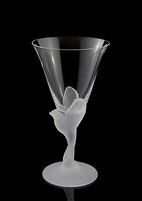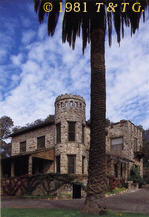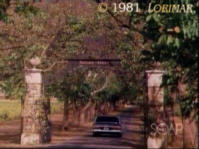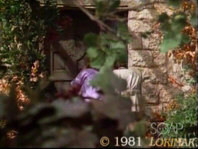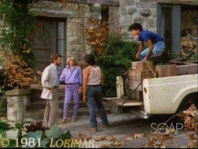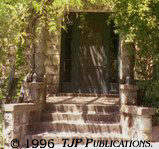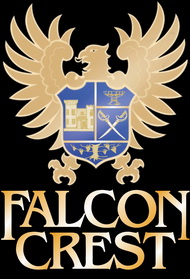
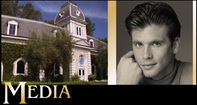
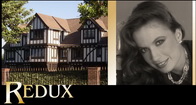

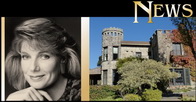

|
General Information
 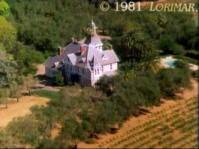 The major filming location of the series was Spring Mountain Vineyards in St. Helena, CA. Besides exterior footage on the winery grounds, the pilot's interior scenes had already been filmed on the first floor of its Victorian Mansion (Villa Miravalle). As MICHAEL and SUSAN ROBBINS, the winery's owners in those days, were shocked at their parquet floors being scratched by the production equipment, filming inside the house was out of the question for future episodes. The major filming location of the series was Spring Mountain Vineyards in St. Helena, CA. Besides exterior footage on the winery grounds, the pilot's interior scenes had already been filmed on the first floor of its Victorian Mansion (Villa Miravalle). As MICHAEL and SUSAN ROBBINS, the winery's owners in those days, were shocked at their parquet floors being scratched by the production equipment, filming inside the house was out of the question for future episodes.LORIMAR's original drawings and sketches of this filming location are available for DFCF members in the Show – Production Office – Filming Locations – Distant Locations section.
As for the wine bottle in the promo photos, detailed information about this wine label and many others is available in the Show – Production Office – Wine Label Gallery section. Previews are available for the general public; for DFCF members, the wine labels are available in high resolution. 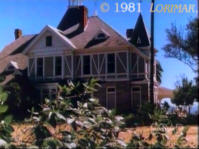 For the series, sets resembling the Victorian Mansion's interiors (and, during season 2, the front veranda) were built on sound stage 1 of THE BURBANK STUDIOS (nowadays WARNER BROS. STUDIOS) in Burbank, CA. The first floor of the Mansion is quite the same as the one of the real Villa. Slight differences are that there are three steps from the entrance into the foyer and that the foyer set is wider (in both directions); the small lavatory under the stairway is missing in the foyer set; the living room set is wider in north-south direction, but not as wide in the east-west direction as in the real Villa, and the small tower to the south was not replicated in the set; the windows to the south and west in the living room set are in different shape (a semi-circular arrangement) compared with the real ones; while the living room and the dining room each have double pocket doors, each of the real Villa Miravalle's pocket doors to the respective rooms have one sliding panel only. For the series, sets resembling the Victorian Mansion's interiors (and, during season 2, the front veranda) were built on sound stage 1 of THE BURBANK STUDIOS (nowadays WARNER BROS. STUDIOS) in Burbank, CA. The first floor of the Mansion is quite the same as the one of the real Villa. Slight differences are that there are three steps from the entrance into the foyer and that the foyer set is wider (in both directions); the small lavatory under the stairway is missing in the foyer set; the living room set is wider in north-south direction, but not as wide in the east-west direction as in the real Villa, and the small tower to the south was not replicated in the set; the windows to the south and west in the living room set are in different shape (a semi-circular arrangement) compared with the real ones; while the living room and the dining room each have double pocket doors, each of the real Villa Miravalle's pocket doors to the respective rooms have one sliding panel only.Exterior shots were filmed at Spring Mountain in July or August every year between 1981 and 1987. It is obvious that the episodes at the beginning of each season feature a lot more exterior scenes than later episodes. The other sets at THE BURBANK STUDIOS were located on other sound stages, most of them on stages 19 (the Gioberti House, in particular) and 19 A, both of which were exclusively used for the series. LORIMAR's original blueprints of many sets are available for DFCF members in the Show — Production Office – Filming Locations – Movie Studios – Interior Sets section.
LORIMAR's original drawings and sketches of this filming location are available for DFCF members in the Show – Production Office – Filming Locations – Distant Locations section. You can find more details about these and other filming locations in our Travel Guide. Location filming in the Wine Country was done for # 001 through # 007. Full family trees of the Giobertis and Agrettis including dates (birth, death, marriages, etc.) are available here. During seasons 1 through 4, JANE WYMAN also serves as the announcer for the sneak previews of the following episode in every show — besides announcer ROY ROWAN. CLU GULAGER and SAMANTHA EGGAR, who played Chase and Maggie Gioberti on the predecessor, were not rehired. ROBERT FOXWORTH and SUSAN SULLIVAN gained the rôles instead. MARIAN McCARGO BELL, BILLY R. MOSES' mother, also auditioned for the Maggie character, but was turned down because producers felt she was too old; she will appear as a guest, playing Harriet Roberts, in season 5. Original plans included a second son to Gus and Alicia Nuñez, Lupe (age 10); this character, which was originated in "The Vintage Years", was erased from the series very shortly before shooting began. Familiar Faces at LORIMAR: The production company preferred hiring "old friends", who had done good jobs for the company in the past. EARL HAMNER brought many crew members from his previous LORIMAR show, "The Waltons", over to "Falcon Crest", including ERNIE WALLENGREN, KATHLEEN HITE, KATHARYN POWERS (writers), HARRY HARRIS, LARRY ELIKANN, MICHAEL PREECE (directors) and SANDY COURAGE (music). Producer BARRY STEINBERG (joining in # 013) previously worked as a unit production manager on "Flamingo Road"; so did art director ARCH BACON. 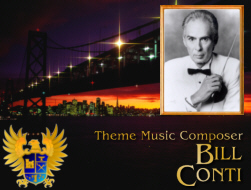 Popular movie and TV composer BILL CONTI serves as the show's theme composer and as the composer of the score for # 001. Popular movie and TV composer BILL CONTI serves as the show's theme composer and as the composer of the score for # 001.The first core element of the theme resembles a very short part during the beginning of the somber clarinet solo of "E lucevan le stelle" ("When the Stars Were Brightly Shining"), the aria (romanza) of the Mario Cavaradossi character, in the third act of "Tosca", the opera by GIACOMO PUCCINI. The series was originally scheduled to première on Sept 25, 1981. A writers' strike prevented finishing the episodes in time so the première was moved to Dec 4, 1981, following the decision that the first seven episodes would be entirely staff written to avoid any further delay. At first, CBS ordered the original pilot ("The Vintage Years") plus 12 episodes with an option for additional episodes. LORIMAR developed more episodes for season 1 than originally sold to CBS in order to be prepared in case the network wanted to extend the season. Story outlines for the following episodes were written, but the further development of these episodes was dropped:
In Europe, Australia and many countries in South America, the speed of the episodes as aired on TV is a bit faster compared to the original U.S. version (NTSC TV system). This is caused by the telecine transfer (the conversion) from the film reel to PAL (the common TV system in most European and South American countries as well as in Australia). Whereas transferring film to NTSC does not cause any acceleration, transferring film to PAL results in a 4 % acceleration, i.e. the 24 fps (frames per second on film) will be converted into 50 pictures per second. This results in the episodes running at film speed multiplied by 1.04 and, therefore, 4 % less screen time — before any re-editing in syndication. This, however, usually does not strike the human eye. ← Predecessor... → Next episode... |
